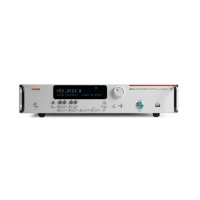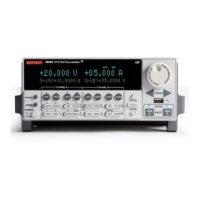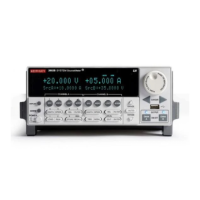2600S-901-01 Rev. C / January 2008 Return to Section Topics 12-13
Series 2600 System SourceMeter® Instruments Reference Manual Section 12: Instrument Control Library
Usage value = bit.get(value1, index)
value1 Given number.
index Index position of the bit to be retrieved (1 to
32).
value Returned weighted value of the bit.
Remarks • This function returns the value of the bit in value1 at the given index. This is the same
as returning value1 with all other non-indexed bits set to zero.
• Prior to retrieving the indexed bit, any fractional part of the given number will be truncated
to make it an integer. The least significant bit of the given number has an index of 1 and
the most significant bit has an index of 32.
• If the indexed bit for the number is set to 0, the result will be 0.
•See “Logic and bit operations” on page 12-10 for more information.
Also see bit.clear, bit.getfield, bit.set, bit.setfield, bit.test, bit.toggle
Example The binary equivalent of decimal 10 is 1010. Getting the bit at index position 4 will
return decimal
value 8:
value = bit.get(10, 4)
print(value)
Output: 8.000000e+00
bit.getfield
Function Returns a field of bits starting at a given index position.
Usage value = bit.getfield(value1, index, width)
value1 Given number.
index Index position of the first bit; 1 to (33 – width).
width Field width – number of bits to be included in the
field; 1 to 24.
value Returned value of the bit field.
Remarks • A field of bits is a contiguous group of bits. This function retrieves a field of bits from
value1 starting at the given index position. The index position is the least significant
bit of the retrieved field. The number of bits to return is given by width.
• Prior to retrieving the field of bits, any fractional part of the given number will be truncated
to make it an integer.
• The least significant bit of the given number has an index of 1 and the most significant bit
has an index of 32.
•See “Logic and bit operations” on page 12-10 for more information.
Also see bit.clear, bit.get, bit.set, bit.setfield, bit.test, bit.toggle
Example The binary equivalent of decimal 13 is 1101. The field at index2 and width3
consists of the binary bits 110. The returned
value will be decimal 6 (binary 110):
value = bit.getfield(13, 2, 3)
print(value)
Output: 6.000000e+00
bit.set
Function Sets a bit at a given index position.
Usage value = bit.set(value1, index)
value1 Given number.
index Index position of the bit to be set (1 to 32).
value Returned value of the new number.
Remarks • This function returns value, which is value1 with the indexed bit set. The index must
be a value between 1 and 32. The least significant bit of the given number has an index
of 1 and the most significant bit has an index of 32.
• Any fractional part of value1 will be truncated to make it an integer.
•See “Logic and bit operations” on page 12-10 for more information.
Also see bit.clear, bit.get, bit.getfield, bit.setfield, bit.test, bit.toggle

